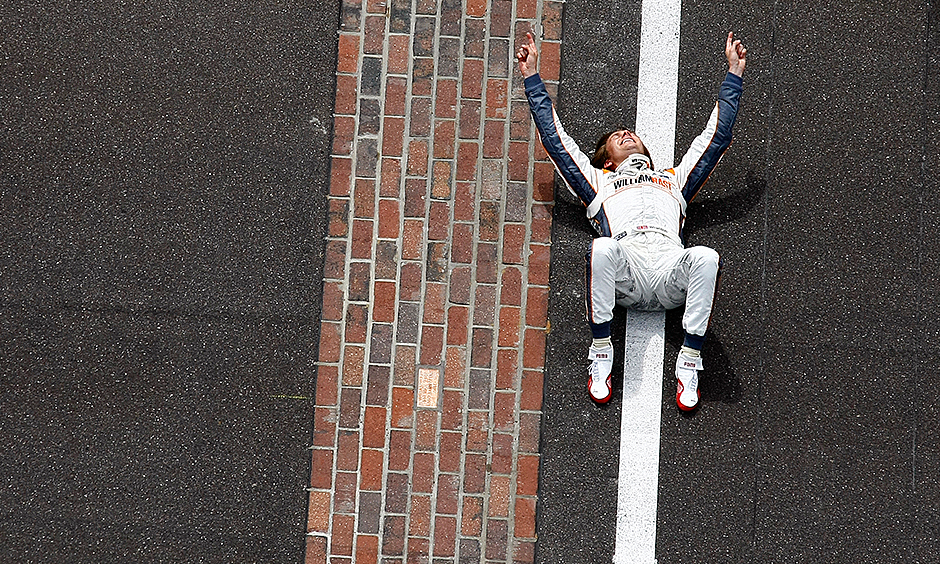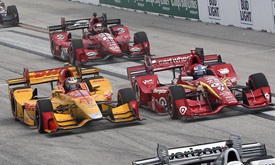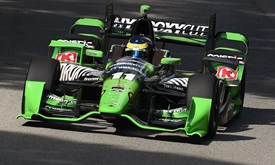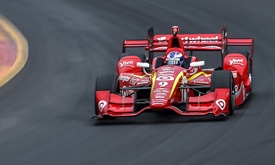Remembering 'Lionheart' on his birthday
JUN 22, 2016
(Today, on what would have been his 38th birthday, INDYCAR remembers Dan Wheldon, the 2005 Verizon IndyCar Series champion and 2005 and ’11 Indianapolis 500 winner. No better way to do so than with an excerpt from “Lionheart – Remembering Dan Wheldon,” a compilation of stories about the charismatic Brit from fellow competitors, friends, family and others. What follows is the chapter written by Mike Kitchel, the public relations representative for Panther Racing when Wheldon drove for the team from 2009-10. Kitchel is now director of communications at INDYCAR. To order “Lionheart,” click here.)
My youngest son is unbelievably particular. Everything must be organized perfectly or he gets irritable and restless. He’s very selective about what he wears and refuses to put on any piece of clothing he doesn’t pick out himself. His shoes, specifically, must always be immaculate. Anytime he’s in a room, he’s the center of attention with no exceptions. He’s disarmingly charming and a damn good-looking kid – which is complicated by the fact he knows it.
Max Daniel is 3 years old.
My son’s similarities with the behavioral nuances of Dan Wheldon, while eerie, are merely a coincidence. His middle name is not. It serves as a constant reminder for our family to embody the distinctive qualities that made DW’s impact on us so profound. The race wins, championships and Indianapolis 500 victories made him a legend, but there is no statistic for what truly made him great. It wasn’t just the charisma, the compassion, the engaging sense of humor and the legendary practical joking. Or the relentless drive for excellence, meticulous attention to detail or brutal unwillingness to accept anything less than perfection.
What always amazed me most about DW was the amount of time he invested in his innate ability to make people feel special. It wasn’t just for his friends, teammates, sponsors or the hordes of race fans he saw at the track. It was volunteers, cashiers, hotel clerks, waitresses, janitors and the countless number of other people who crossed his path each day – many of whom had no idea that he drove race cars for a living. Yet, somehow, he managed to find some laughter in all of them.
Once, with a night race on the slate at Kentucky Speedway, we had an afternoon to kill and the two of us plus Panther Racing colleague Benito Santos and Dan’s assistant, Misty Gibbs, stopped for lunch near the track. Our usual recipe of laughter, insults and storytelling were in full swing when out of the corner of my eye I noticed DW had been spotted by a family of race fans who had just entered the restaurant.
They eventually approached the table, somewhat sheepishly, but it was clear their enthusiasm was difficult to contain. They’d come from Chicago, they said, and never missed a race at Kentucky Speedway. Their excitement was tempered by the obvious sense that they were uncomfortable interrupting our lunch. They wrapped up the conversation quickly, wished Dan luck and found their seats on the other side of the restaurant.
Dan’s wheels were turning. We knew what was coming.
“How far is Chicago from here?” Wheldon asked, clearly awed at the length they’d driven to see a Verizon IndyCar Series race. “That’s like a six- or seven-hour drive with traffic, right?”
We all pulled out our phones to find an answer, but by this point it was no matter. Dan reorganized his lunch onto its tray and excused himself from the table. He knew an easy way to ensure the drive was worth their time. Before our phones were back in our pockets, Wheldon had found another seat and was having lunch with his new friends from Chicago. Suddenly, the laughter that had been present at our table was coming from the other side of the restaurant.
One of the first appearances we did together was the SKUSA SuperNats go-kart race in Las Vegas. Dan loved karting and the SuperNats is the sport’s Indianapolis 500. The National Guard was a sponsor of the event, which included a ride for DW to compete in the race. What I figured was a chance for him to get a free weekend in Vegas to spend some face time with his primary sponsor was much more.
The first practice session of the weekend was quickly approaching and Dan was holding court outside his team’s garage with a group of kids all wearing firesuits and holding their helmets. He was 2 feet taller, and nearly 20 years older, than everybody in the crowd and the only one that didn’t seem to notice. From the outside he was a superstar race car driver doing his part to give back, but in that moment Dan Wheldon was just another kid at a go-kart track talking shop with his competitors.
He knew most of their names and what divisions they were running in during the weekend. He pointed out specific on-track passes, forgettable mistakes or otherwise memorable moments he’d seen while watching them compete. He joked that they should take it easy on the old man on the kart track, but that he wasn’t going to return the favor if any of them made it to the Verizon IndyCar Series. The crowd of young go-kart drivers all tried desperately to play it cool, but their eyes were wide.
As Dan finally broke away from the crowd to rush to pit lane for practice, a young boy and his father had been waiting patiently around the corner to ask for an autograph. The signature was quick, but the recipient had a few questions about karting, and the green flag on Dan’s practice session was imminent.
He apologized profusely as he quickly wrote down his email address next to his autograph with explicit instructions to send him all of his karting questions and a promise that he’d get a prompt reply to all of them. The boy’s father clearly appreciated the gesture, but couldn’t withhold his skepticism.
“Those emails,” the father asked, leaning in to speak to me. “Do they go to a personal assistant or something?”
I could only smirk.
“We sent his INDYCAR contract to the same email address,” I replied. “Make sure your son uses it.”
Every year in Indianapolis, Dan would make a personal appearance at Peyton Manning Children’s Hospital at St. Vincent to visit with sick children. At each of these visits, DW would meet with the kids, get to know each of them and leave behind a worksheet with a blank template of a race helmet for them to draw any design they wanted. Once the appearance was completed, he would select the kid that inspired him the most and have his helmet painted with their design for a race later in the year.
When the hour scheduled for our appearance concluded and we were finished visiting all the rooms that were planned, Dan asked if he could see more kids. Once we’d cleared another hospital floor, he directed our entire group back to the elevators so we could visit another. When the nurses finally convinced him there were no more kids he’d be allowed to see, he wanted to make a return visit to one young cancer patient he couldn’t get out of his head.
Jama was sassy – a self-assured adult spitfire trapped in an 8-year-old’s body. Her medical prognosis was bad, but she showed little interest in dwelling on it. We spent the rest of the time hanging out with Jama – she gave us a tour of her hospital floor and introduced us to almost every nurse and doctor in the building. We wore out our welcome at approximately the same time DW took her to the front desk of the hospital and instructed her to answer the receptionist’s phone each time it rang. An elderly woman working the desk wasn’t impressed, but that only provided additional encouragement. The more awkward it got for everybody else, the more fun it was for Jama and Dan.
When Dan finally left – which only happened because he was late to pick up his wife Susie from the airport – he’d been at the hospital for over five hours.
One of my few PR mentors, the late John Cardinale from Sonoma Raceway, had arranged for a media tour that included an event at the iconic Boudin Bakery in San Francisco. Dan was going to make “an Indy car out of sourdough bread” which, normally, would draw a laugh and rejection – but with John you always said yes because he could seemingly make anything a national news event. In addition to the event at the bakery, we were scheduled to make three or four other stops at TV and radio stations in the area. John, knowing it was important for DW to always arrive in style, arranged for a limousine to take us around San Francisco for the day.
Our limo driver was a gentleman named Dave and extremely shy, to the point it bordered on being socially awkward. But Dave was a genuinely nice person clearly going out of his way to keep us on schedule during a hectic day. Dan engaged Dave in every conversation, including a few inappropriate ones, for the entire day. When we stopped for lunch, Dave joined us and was not permitted to stay in the limo as his boss typically requires. It’s entirely possible that throughout the course of our tour DW asked Dave more questions than he’d received from media the entire day.
As the media tour concluded, Dan assured our new friend that he’d have a pair of VIP passes waiting for him at the race in Sonoma later that year. When race weekend finally arrived, we didn’t get a chance to see Dave until just before the race when the cars were on the grid. But DW ran up and gave him a hug, met his wife and relived a few quips from our ride together a month or so earlier. As Dave walked around the car to take a few pictures, I went to introduce myself to his wife. When I got closer, I realized she had tears in her eyes.
“Nobody acknowledges Dave when he’s driving, but all he talks about is how cool it would be to become friends with the celebrities that ride in his limo,” she said. “This time he really did.”



















